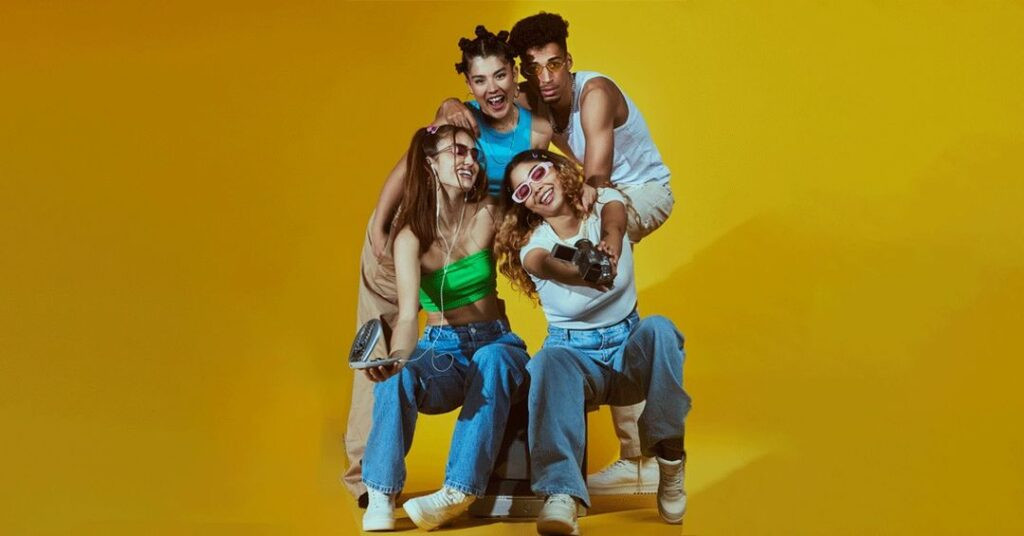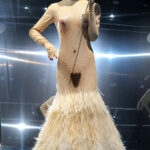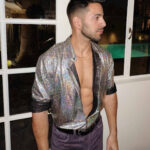Fashion From 2003 was a unique blend of styles, and mens-fashion.net is here to help you navigate its resurgence. This era, known for its bold experimentation and individuality in menswear, is influencing contemporary trends. We will explore how you can incorporate these vintage styles into your modern wardrobe.
1. What Were The Key Fashion Trends of 2003?
Key fashion trends of 2003 included a mix of casual and slightly more edgy styles, reflecting a sense of laid-back confidence. The year saw a rise in popularity of certain styles and materials that defined the era. These trends were prominent both on the streets and in high-fashion runways, influencing what men chose to wear daily.
- Satin Fabrics: Satin was a prominent fabric, used in bomber jackets, shirts, and even cargo pants. Its luxurious sheen added a touch of glamour to everyday wear.
- Sportswear Elements: Sportswear was integrated into daily fashion, with satin bomber jackets and sporty T-shirts becoming commonplace. This blend of comfort and style was a defining aspect of the era.
- Oriental Influences: Chinese and Japanese styles were evident, with mandarin necklines, embroidered dragons on T-shirts, and accessories featuring soutache braid. These elements added an exotic touch to mainstream fashion.
- Color Palette: The color palette was diverse, including taupe, beige, chocolate, pastel pinks, and stronger colors like poppy red and electric blue. Mixing and matching these colors allowed for individual expression.
- Accessories: Accessories included pearls, diamante, and metallic shoes, enhancing the overall glamorous feel. These details added sophistication to both casual and formal outfits.
 Man in a satin bomber jacket and cargo pants
Man in a satin bomber jacket and cargo pants
2. How Did Spring/Summer 2003 Influence Men’s Fashion?
Spring/Summer 2003 brought a wave of feminine and colorful designs to men’s fashion, challenging traditional norms and introducing a playful aesthetic. This season was about embracing lighter fabrics and bolder color palettes. According to a study by the Fashion Institute of Technology (FIT), the Spring/Summer 2003 collections emphasized individuality and self-expression through clothing.
- Color Trends: The color palette included soft rose, antique pink, dusty pink, ochre, gold, pale olive green, and various shades of blue and red. These colors created a vibrant and refreshing look.
- Pastels and Sherbet Colors: Soft color mixtures, such as pastel pink with creamy lemon, created an ethereal and feminine mood. These colors were often seen in lightweight fabrics, perfect for warmer weather.
- Fluorescent Colors: Hot pinks, electric blue, sea green, peachy orange, and canary yellow added a bold, exotic touch. These colors were reminiscent of tropical floral prints and butterfly wings.
- Fabric Choices: Chiffons and satins were popular, adding a glamorous and elegant touch. These fabrics were used in shirts, jackets, and accessories.
- Styling: Mixing bright colors with safer tones like taupe or gray was a popular styling choice. This allowed men to experiment with bolder colors while maintaining a balanced look.
3. What Autumn/Winter 2003-2004 Fashion Colors Were Popular?
Autumn/Winter 2003-2004 saw a continuation of soft ice cream-like colors, along with the introduction of metallic sheens and strong fruit shades, creating a dynamic and interesting mix. The metallic sheen was a signature element, adding depth to clothing. According to Esquire magazine, this season was about blending comfort with a touch of glamour.
- Fondant Colors: Pistachio green, ecru, pale gold, buttercup yellow, camel, tea rose, raspberry pink, and dusty pink were prominent. These soft colors provided a comforting and stylish look.
- Metallic Casts: Many winter colors had a metallic cast or gunmetal sheen, adding exciting dimensions to clothing. This effect was particularly noticeable in greys, which ranged from blonde to deepest black.
- Strong Fruit Shades: Some schemes included strong colors with fruit shades, influenced by the 1960s. These shades added a vibrant and retro touch to the season.
- Neutral Tones: Truffle, cigar, and blued charcoal were top colors, with red and metallic shimmers bringing a dynamic note. These neutral tones provided a versatile base for various outfits.
- Fabric Trends: Embroidered chiffons, plaids, and tapestry-style jacquard fabrics with metallic yarns were popular. These fabrics added texture and luxury to winter wardrobes.
4. How Did Fabric Trends Define the Fashion of 2003?
Fabric trends in 2003 were diverse, ranging from light, airy chiffons and satins to rich, textured jacquards and metallic brocades, each contributing to the unique aesthetic of the year. The choice of fabric often dictated the style and occasion for which a garment was suited. According to GQ magazine, fabric choices were pivotal in defining the overall look and feel of the year’s fashion.
- Spring/Summer Fabrics: Mist-like chiffons and satins were the biggest looks, bringing movie star glamour to everyday wear. Satin was used in bomber jackets, off-the-shoulder tops, mini skirts, and dresses.
- Satin Styling: Slender men could easily wear satin, while those with larger frames were advised to choose satin items like tops or shirts to wear under jackets. This allowed everyone to incorporate satin into their wardrobe.
- Pearls and Diamante: These accessories enhanced satin looks, adding to the luxurious and glamorous feel. They were often paired with gold or silver sandals.
- Autumn/Winter Fabrics: Embroidered chiffons, plaids, tapestry-style jacquard fabrics with metallic yarns, and metallic brocades were popular. These fabrics added depth and texture to winter wardrobes.
- Other Notable Fabrics: Pastel suede lined with patterned soft fine fleeces, macramé style lace knits, laser-cut work, and contrast fabric bonding were also significant. These fabrics offered a range of textures and styles for different occasions.
5. What Key Fashion Styles Dominated 2003-2004?
The fashion styles of 2003-2004 were diverse, offering something for everyone, from floaty tea dresses and satin sportswear to Chinese/Japanese styling and techno sporty looks. This variety allowed individuals to express their unique style preferences. According to runway reports, the era was about blending different cultural and stylistic elements.
- Floaty Tea Dresses: These dresses provided a feminine and elegant option for warmer months. They were often made of chiffon or lightweight fabrics.
- Satin Sportswear: Satin bomber jackets and sporty T-shirts combined comfort with a touch of glamour. This trend blurred the lines between casual and formal wear.
- Chinese/Japanese Styling: Mandarin necklines, embroidered dragons, and soutache braid details added an exotic touch to outfits. These elements were seen in both clothing and accessories.
- Techno Sporty: This style incorporated modern, athletic-inspired designs with sleek lines and innovative materials. It was a forward-looking trend that appealed to those interested in futuristic fashion.
- Cinched Waists and Mini Skirts: These styles were popular among younger individuals. Mini skirts, in particular, were often paired with solid block-colored tights and flat boots for a chic look.
6. How Can You Incorporate 2003 Fashion Trends Into Your Modern Wardrobe?
Incorporating fashion from 2003 into your modern wardrobe involves selecting key elements and styling them in a contemporary way to avoid looking dated. The goal is to blend vintage charm with current trends, creating a unique and stylish look. According to fashion stylists, the key is to pick a few standout pieces and build your outfit around them.
- Satin Pieces: Choose a satin bomber jacket or shirt and pair it with modern jeans or tailored trousers. This adds a touch of luxury without overwhelming your outfit.
- Sporty Elements: Incorporate sporty T-shirts or track pants with contemporary sneakers and a stylish jacket. This creates a balanced and fashionable look.
- Oriental Details: Add a Chinese-inspired embroidered scarf or a mandarin-collar shirt to your outfit. These details can add an exotic touch without being over the top.
- Color Palette: Use colors like taupe, beige, and pastel pinks as a base and add pops of brighter colors like poppy red or electric blue. This keeps your outfit fresh and modern.
- Accessories: Opt for minimalist jewelry and modern shoes to balance the vintage-inspired clothing. This prevents the outfit from looking too retro.
7. What Fashion Items From 2003 Should Be Avoided?
While many 2003 fashion trends can be revived, some items should be avoided to prevent your look from appearing outdated. These are pieces that were very specific to the era and may not translate well into modern styles. According to fashion critics, avoiding these items is crucial for a contemporary revival.
- All-Over Tans: Avoid overly tanned skin, which was a trend in 2003. Instead, opt for a more natural skin tone.
- Thigh-High Slits: Dresses with long thigh slits can look dated. Choose dresses with more subtle slits or different silhouettes.
- Rigid Bustiers: These are no longer in style and can look out of place in modern outfits. Opt for more comfortable and contemporary tops.
- Dungarees: These were a popular item in 2003 but are best avoided now. Choose overalls or jumpsuits with more modern cuts and styles.
- Tassels and Frilly Skirts: These details can make an outfit look overly retro. Opt for cleaner lines and simpler designs.
8. What 2003 Fashion Items Should Be Kept?
Certain fashion items from 2003 are timeless and can be easily incorporated into modern wardrobes, adding a touch of vintage charm and versatility. These pieces often have classic designs that transcend specific eras. According to fashion historians, these items are worth keeping for their timeless appeal.
- Denim Items: Keep all your denim items, such as jeans, jackets, and shirts. Distressed denim is especially trendy and can be styled in various ways.
- Military Items: Military-inspired coats and combat pants can be paired with high heels or modern boots for a stylish contrast.
- Chiffon Pieces: Chiffon tops, dresses, and scarves are great for layering and adding a touch of elegance to any outfit.
- Satin Garments: If you have satin shirts or jackets, keep them for adding a luxurious touch to your wardrobe.
- Accessories: Pearls and diamante accessories can be used to enhance both casual and formal outfits.
9. How Can Accessories Elevate a 2003-Inspired Look?
Accessories play a crucial role in elevating a 2003-inspired look, adding sophistication and personality while ensuring the outfit remains modern and stylish. The right accessories can transform a simple outfit into a fashion statement. According to accessory designers, the key is to choose pieces that complement the overall aesthetic.
- Pearls and Diamante: These accessories add a touch of glamour and can be used to enhance satin or chiffon outfits.
- Metallic Shoes: Gold or silver sandals and heels were popular in 2003 and can be paired with dresses or skirts for a chic look.
- Thin Strappy Sandals: These sandals are a classic choice and can be worn with a variety of outfits.
- Oriental-Inspired Accessories: Embroidered scarves and bags with soutache braid details can add an exotic touch.
- Modern Jewelry: Minimalist necklaces, bracelets, and rings can balance the vintage-inspired clothing and keep the look contemporary.
10. Where Can You Find Inspiration and Shop for 2003 Fashion Today?
Finding inspiration and shopping for 2003 fashion today involves exploring vintage stores, online marketplaces, and modern retailers that offer pieces inspired by the era. The key is to mix and match vintage finds with contemporary items for a unique and stylish look. According to fashion bloggers, several resources can help you find the perfect pieces.
- Vintage Stores: Explore local vintage stores for authentic 2003 pieces, such as satin jackets, chiffon tops, and denim items.
- Online Marketplaces: Websites like Etsy, eBay, and Depop offer a wide selection of vintage and retro clothing.
- Modern Retailers: Look for contemporary brands that offer pieces inspired by 2003 fashion trends, such as satin bomber jackets, sporty T-shirts, and oriental-inspired accessories.
- Fashion Blogs and Magazines: Follow fashion blogs and magazines for inspiration on how to style 2003-inspired outfits in a modern way.
- Social Media: Platforms like Instagram and Pinterest can provide visual inspiration and links to retailers selling relevant pieces.
Reviving fashion from 2003 can be a fun and creative way to express your personal style. By carefully selecting key pieces and styling them in a contemporary way, you can create a unique and fashionable look that pays homage to this iconic era.
Looking to explore more fashion trends and get expert advice? Visit mens-fashion.net today to discover a wealth of articles, style guides, and tips to elevate your wardrobe and stay ahead of the latest fashion developments in the USA. Our team of experts is dedicated to providing you with the most up-to-date and practical information, ensuring you always look your best.
Address: 227 W 27th St, New York, NY 10001, United States
Phone: +1 (212) 217-5800
Website: mens-fashion.net
FAQ: Fashion From 2003
1. What made fashion from 2003 distinct?
Fashion from 2003 was distinct due to its blend of casual and edgy styles, marked by satin fabrics, sportswear elements, and oriental influences, creating a laid-back yet glamorous aesthetic.
2. Which colors defined spring/summer 2003 fashion?
Spring/Summer 2003 fashion was defined by colors like soft rose, antique pink, ochre, gold, pale olive green, and fluorescent shades like hot pink and electric blue, creating a vibrant and feminine palette.
3. What fabrics were popular in 2003?
Popular fabrics in 2003 included mist-like chiffons, satin used in bomber jackets and dresses, tapestry-style jacquard fabrics, and metallic brocades, each adding unique textures and glamour.
4. How did Chinese/Japanese styling influence fashion in 2003?
Chinese/Japanese styling influenced fashion in 2003 through mandarin necklines, embroidered dragons on T-shirts, and accessories featuring soutache braid, adding an exotic and sophisticated touch.
5. Which fashion items from 2003 should be avoided today?
Fashion items from 2003 to avoid today include all-over tans, dresses with long thigh slits, rigid bustiers, dungarees, and heavily tasseled or frilly skirts, which can make an outfit look dated.
6. How can satin be incorporated into a modern wardrobe inspired by 2003?
Satin can be incorporated by choosing a satin bomber jacket or shirt and pairing it with modern jeans or tailored trousers, adding a touch of luxury without overwhelming the outfit.
7. What accessories can elevate a 2003-inspired look?
Accessories that elevate a 2003-inspired look include pearls, diamante, metallic shoes, thin strappy sandals, and minimalist modern jewelry to balance vintage elements with contemporary style.
8. Where can I find inspiration for 2003 fashion trends today?
Inspiration for 2003 fashion trends can be found in vintage stores, online marketplaces like Etsy and eBay, modern retailers offering retro-inspired pieces, fashion blogs, magazines, and social media platforms.
9. How can I mix 2003 trends with current fashion for a modern look?
To mix 2003 trends with current fashion, select key vintage elements like a satin jacket or chiffon top and pair them with modern pieces like tailored trousers or contemporary sneakers for a balanced outfit.
10. Why is it important to carefully select and style 2003 fashion items?
It’s important to carefully select and style 2003 fashion items to avoid looking dated and to ensure the outfit remains fresh, stylish, and reflects a contemporary aesthetic.

